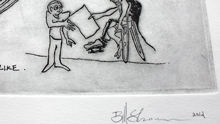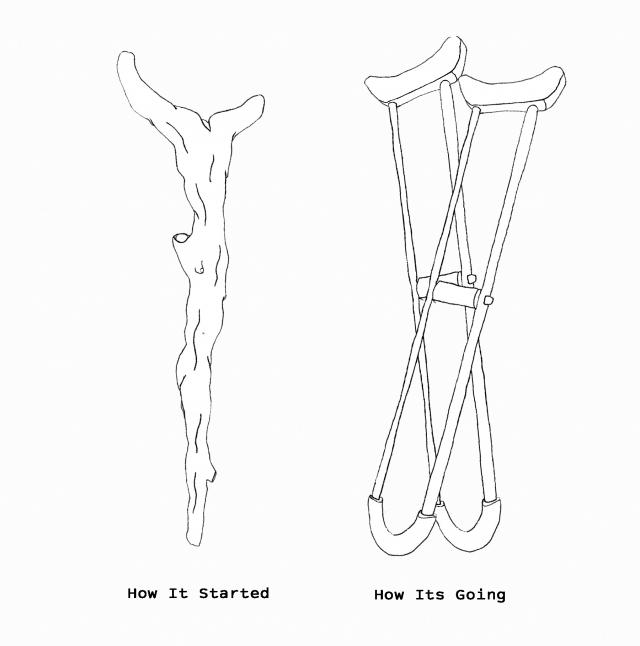TShirts, Stickers, Prints, Art Objects
WhatIsWhat 1.0 2003
The First Crutch
ABOVE: "How Its Going: Crutches" Text and Line Art by Bill Shannon
What was the first crutch? It was not the first recorded crutch. It was not the first staff. The first crutch was before it all. It was a branch. A branch grabbed on impulse to survive a moment, to get through a threatening situation. The first crutch was a life and death situation. The first crutch was born of a moment when a human, under threat from a predator, impulsively invented a tool to assist their own mobility. Crutches at their essence are rooted in survival. Crutches are a sign that the person using the crutches is likely the weakest in the pack. Crutches, in short, equal death. That survival response to seeing crutches is still with us today, at the very core of our innate survival instinct. Mortality symbolized in an object that one uses to move their body. The first crutch, before it was a crutch, was a random branch from a tree that had fallen to the ground. It was laying in a specific place, sufficiently thick but not too thick, the correct length, not too long or too short. Just the right length to work for the human that happened to pick it up.(cont.)
Rewind through human history to this moment. A group of humans passing through a forest. They come across a group of lion cubs. When the group sees the cubs come bounding into a clearing they realize that a protective mother is somewhere in the vicinity and will immediately charge the group on sight. The group of humans begins to run away. The sound of running alerts the mother lion who takes chase. The group begins to run and scatter. One of the members of the group, lets call them Furst twists their ankle running quite badly. Furst falls and attempts to get up and run again but their foot will not support their weight as they hop along reaching down to the ground even as the lioness is moving in. Just then Furst comes across a branch laying in the brush that is hard and dry. They instinctively grab the branch without planning, a decision from the gut pick up the branch and then use it to push into the ground without bending over. Furst holds the crutch parallel with their hurt leg and is able to move more upright. Their fear and their adrenaline have taken over their mind as they begins to use the crutch to climb up the side of a hill and can see that they are no longer being chased by the lioness. Eventually the group recollects and Furst rejoins her group still with the crutch. Fursts partners in the group, clan or tribe as you will are looking at Furst with new eyes. They see that Furst is using the crutch but do not feel at ease with the use of the crutch because it sets Fursts apart. It attracts attention, it shows weakness. Furst is different now not just slower physically but also slowly over time begins holding a lesser status in the group socially due to their continuing introduction of vulnerability in mulitple situations arising in the daily activities of survival. Fursts ankle takes weeks to heal and when it does heal Fursts stops using the crutch completely. The symbolism of the crutch was remembered by the group and it was used again when another member had a fall and broke their leg. This time the crutch became a permanent fixture as the other members healing of the leg was never fully complete. The leg remained only partially functional. The crutch kept their user mobile and alive but also marked them as most likely to die. That user of the crutch developed social skills and built value within the group through other means than moving as the others did. They began to think different, to solve problems that diverged from the established patterns and introduced those solutions when the time became available.
Thats my story of the first crutch. Its how I imagine it would have been. Its also where my work in public space plays with the idea that the spectacle of disability in public space and the use of a mobility aid, though generations evolved, still at its core touches on the deep seated impulse hardwired within the human brain to survive and take notice of any threat or vulnerability that runs counter to that core goal. So the next time you have an interaction with someone using a mobility aid, or representing the condition of a visible disability, you can try and listen in to the gut response that lies under the known and practiced interactions of the everyday. Listen for that very initial gut moment before the brain kicks in. Thats Furst saying hello.


